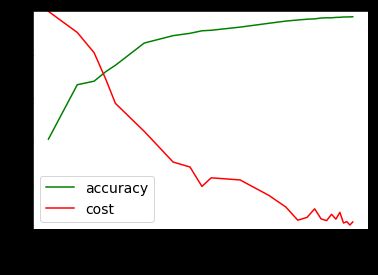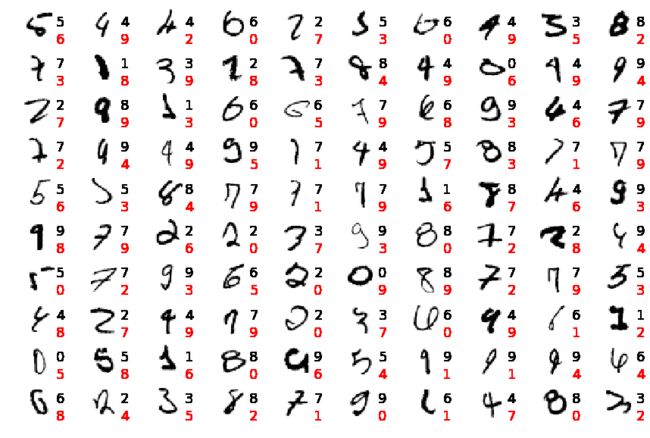这是我Deep_in_mnist系列的第二篇博客
- 注意:这里的代码都是在Jupyter Notebook中运行,原始的
.ipynb文件可以在我的GitHub项目主页上查看,其中的ANN_by_TensorFlow_with_one_hidden_layer.ipynb就是这篇博客的文件,里面包括代码、注释以及交互式运行结果,界面十分友好,读者可以下载后直接在Jupyter Notebook中打开即可,在这里作者也强烈推荐使用Jupyter Notebook进行学习。 - 项目主页 GitHub:acphart/Deep_in_mnist 喜欢可以顺便给个star哦 ~~~
介绍
项目介绍
- 这里使用TensorFlow搭建ANN(一层隐藏层)识别mnist手写数字特征
步骤
1. 导入工具库和准备数据
import tensorflow as tf
import numpy as np
import pandas as pd
import matplotlib.pyplot as plt
import os
import warnings
# os.environ['TF_CPP_MIN_LOG_LEVEL']='2'
# warnings.filterwarnings('ignore')
- 这里的
all_mnist_data.csv是重新包装后的所有原始mnist数据,共70000个手写数字,数据详情及下载请阅读我GitHub主页上的介绍GitHub:acphart/Deep_in_mnist
all_data = pd.read_csv('../../dataset/all_mnist_data.csv')
'''划分训练集,交叉验证集和测试集'''
s_size = 70000
tr_r = 50000
cv_r = 60000
s_data = all_data[: s_size]
train = s_data[:tr_r]
cv = s_data[tr_r:cv_r]
test = s_data[cv_r:]
2. 定义向量化函数
def vectorize(y_flat):
'''向量化函数,将数字转换成10维的one-hot向量'''
n = len(y_flat)
vectors = np.zeros((n, 10))
for i in range(n):
vectors[i][int(y_flat[i])] = 1
return vectors
3. 搭建ANN
'''
x, y分别为特征向量和对应的真实值向量,None代表可以同时向网络输入多个数据;
同时x也为网络第1层的激活值,第1层没有偏置。
'''
x = tf.placeholder('float32', [None, 784])
y = tf.placeholder('float32', [None, 10])
'''
w1_2为网络1、2层之间的权重矩阵;b2为第2层的偏置;a2为第2层的激活值。
'''
n_l2 = 100
stddev1 = 1./np.sqrt(784)
w1_2 = tf.Variable(tf.random_normal([784, n_l2], stddev=stddev1))
b2 = tf.Variable(tf.random_normal([n_l2]))
a2 = tf.sigmoid(tf.matmul(x, w1_2) + b2)
'''
w2_3为网络2、3层之间的权重矩阵;b3为第3层的偏置;
y_为第3层的激活值,也是整个网络的输出。
'''
stddev2=1./np.sqrt(n_l2)
w2_3 = tf.Variable(tf.random_normal([n_l2, 10], stddev=stddev2))
b3 = tf.Variable(tf.random_normal([10]))
y_ = tf.sigmoid(tf.matmul(a2, w2_3) + b3)
4. 超参数、代价函数和优化器
'''设置单批数据量大小、迭代次数、学习率、正则化参数'''
batch_size = 100
epoches = 30000
alpha = 0.002
# lmda = 5
'''cross_entropy为交叉熵代价函数'''
cross_entropy = - tf.reduce_sum(y * tf.log(y_) + (1 - y)*tf.log(1 - y_))
'''优化器'''
# cost_func = cross_entropy + lmda/batch_size*(tf.reduce_sum(w1_2**2) + tf.reduce_sum(w2_3**2))
train_step = tf.train.GradientDescentOptimizer(alpha).minimize(cross_entropy)
'''计算预测准确率'''
correct_prediction = tf.equal(tf.argmax(y, 1), tf.argmax(y_, 1))
accuracy = tf.reduce_mean(tf.cast(correct_prediction, 'float32'))
5. 迭代训练
'''初始化全局变量'''
init = tf.global_variables_initializer()
sess = tf.InteractiveSession()
sess.run(init)
index = 20
'''记录训练过程,作学习曲线图'''
epoch_list = []
acc_list = []
cost_list = []
'''迭代训练'''
for i in range(1,epoches+1):
'''每次迭代随机抽取一批数据进行训练'''
batch = train.sample(batch_size)
x_batch = batch.values[:, 1:]
y_batch = vectorize(batch.values[:, 0])
sess.run(train_step, feed_dict={x: x_batch, y: y_batch})
'''跟踪训练过程'''
if i % index == 0:
if(i >= index*5): index = index*10
if i >= 10000: index = 2000
'''计算并输出验证集的准确率及训练集的代价函数值'''
acc = accuracy.eval(feed_dict={x: cv.values[:, 1:], y: vectorize(cv.values[:, 0])})
cost = cross_entropy.eval(feed_dict={x: x_batch, y: y_batch})
print('epoches: {0:<4d}\t cost: {1:>9.4f}\t accuracy: {2:<.4f}'.format( i, cost, acc))
epoch_list.append(i)
cost_list.append(cost)
acc_list.append(acc)
epoches: 20 cost: 300.4771 accuracy: 0.4123
epoches: 40 cost: 271.3025 accuracy: 0.6626
epoches: 60 cost: 243.2697 accuracy: 0.6789
epoches: 80 cost: 205.6114 accuracy: 0.7239
epoches: 100 cost: 173.3042 accuracy: 0.7520
epoches: 200 cost: 134.6437 accuracy: 0.8543
epoches: 400 cost: 92.2489 accuracy: 0.8883
epoches: 600 cost: 85.4235 accuracy: 0.8990
epoches: 800 cost: 58.5701 accuracy: 0.9106
epoches: 1000 cost: 70.4564 accuracy: 0.9131
epoches: 2000 cost: 67.5324 accuracy: 0.9275
epoches: 4000 cost: 46.1206 accuracy: 0.9452
epoches: 6000 cost: 30.1419 accuracy: 0.9553
epoches: 8000 cost: 11.9177 accuracy: 0.9602
epoches: 10000 cost: 15.7994 accuracy: 0.9639
epoches: 12000 cost: 27.5995 accuracy: 0.9654
epoches: 14000 cost: 13.7188 accuracy: 0.9694
epoches: 16000 cost: 11.3136 accuracy: 0.9705
epoches: 18000 cost: 20.0752 accuracy: 0.9704
epoches: 20000 cost: 13.3539 accuracy: 0.9722
epoches: 22000 cost: 22.7526 accuracy: 0.9727
epoches: 24000 cost: 8.0284 accuracy: 0.9741
epoches: 26000 cost: 9.8284 accuracy: 0.9742
epoches: 28000 cost: 5.2056 accuracy: 0.9745
epoches: 30000 cost: 9.4290 accuracy: 0.9753
6. 查看学习曲线
- 看图好像还可以继续迭代下去,但在我这里增加到35000以上就会cost就会变成nan,正确率也突然降到0.1以下,难道是发散了,我也很疑惑~~
- 我在调超参数的过程中,这个网络得到的最好的准确率是98.33%;
- 这里暂时就这样吧,因为要转向CNN了,后面学得更多了再好好优化。
'''做出训练图'''
fig, ax = plt.subplots(1, 1, sharex=True, sharey=True)
cost_list = np.array(cost_list)/cost_list[0]
_ = ax.plot(epoch_list, acc_list, color='g', label='accuracy')
_ = ax.plot(epoch_list, cost_list, color='r', label='cost')
_ = ax.legend()
_ = ax.set_xscale('log')
_ = ax.set_ylim((0.0, 1.0))
7. 测试准确率
- 准确率为0.9749,10000个测试数据里有251个识别错误
correct_prediction = tf.equal(tf.argmax(y, 1), tf.argmax(y_, 1))
accuracy = tf.reduce_mean(tf.cast(correct_prediction, 'float32'))
acc = accuracy.eval(feed_dict={x: test.values[:, 1:], y: vectorize(test.values[:, 0])})
print('accuracy : {0}'.format(acc))
accuracy : 0.9749000072479248
8. 查看识别错误的数字
def show_pic(ax, image, y_=None, label=None):
'''
作图函数:
ax为Matplotlib.Axes对象;
image为单个的mnist手写数字特征向量,image.shape is (784,);
y_为预测值;
label为image对应的真实数字标签。
'''
img = image.reshape(28, 28)
ax.imshow(img, cmap='Greys')
ax.axis('off')
if y_ != None:
ax.text(28, 28, str(y_), color='r', fontsize=18)
if label != None:
ax.text(28, 14, str(label), color='black', fontsize=18)
- 这里输出了前100个识别错误的数字,图中数字右上角黑色数字是真实值,右下角红色数字是预测值,结果表明我们的模型还需要改进,因为这里头有不少人一眼就能认出来的数字,而模型没有识别出来。
prediction = y_.eval(feed_dict={x: test.values[:, 1:], y: vectorize(test.values[:, 0])})
'''将one-hot向量转换为对应数字'''
pred_flat = [np.argmax(pred) for pred in prediction]
n = 10
fig, ax = plt.subplots(n, n, sharex=True, sharey=True)
fig.set_size_inches(15, 10)
ax = ax.flatten()
ax_id = 0
i = 0
while ax_id < n*n :
image_i = test.values[i, 1:]
yi = test.values[i, 0]
pred_i = pred_flat[i]
if pred_i != yi:
show_pic(ax[ax_id], image_i, pred_i, int(yi))
ax_id = ax_id + 1
i = i + 1

